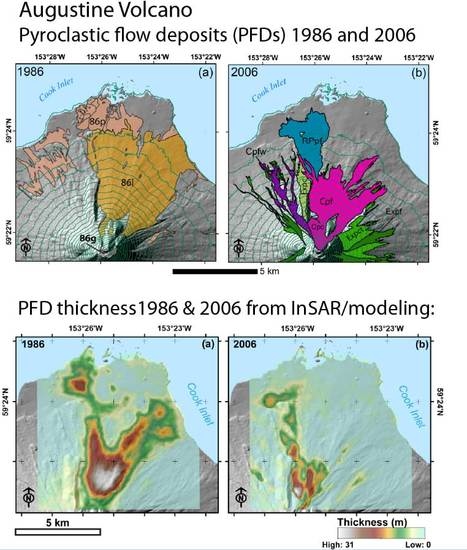Pyroclastic Flow Deposits and InSAR: Analysis of Long-Term Subsidence at Augustine Volcano, Alaska
Abstract
:1. Introduction
2. Augustine Volcano
2.1. The 1986 Eruption and Its PFDs
2.2. The 2006 Eruption and Its PFDs
3. Data Sets
3.1. Available SAR Data
3.2. Ancillary Data Used in This Study
4. Data Processing Methods
4.1. Methods: Differential InSAR (d-InSAR) Time-Series Processing
4.2. Methods: Geophysical Model of PFD Parameter Estimation
4.2.1. Geophysical Considerations and Model Assumptions
4.2.2. Model Formulation
5. Results
5.1. d-InSAR-Based Estimates of Surface Subsidence and 2006 PFD Thickness
5.2. Estimated PFD Parameters for the 1986 and 2006 Deposits
5.2.1. Testing the Approximation of Linearity in the Geophysical Model
5.2.2. Estimating and
- (cm·year−1·m−1) = −0.091; sigma = 0.002
- (cm·year−1·m−1) = −0.319; sigma = 0.005Correlation coefficient between parameters = −0.22
5.2.3. Estimating the Thickness of PFDs Deposited in 1986
- mean thickness (m) = 7.4
- error of thickness estimates (m) = 1.1
- max thickness (m) = 31.5
- total deposition volume (m3) = 4.6 × 107 ± 0.62 × 107
6. Discussion
6.1. Limitations of the Technique
6.2. Scientific Significance of Extracted PFD Information
7. Conclusions
Acknowledgments
Author Contributions
Conflicts of Interest
Appendix A
| Variable | Description |
|---|---|
| N | The number of acquisition times of SAR images in a time series [t0,…tN]. The series starts at zero, resulting in a stack of N + 1 images. |
| The interferometric phase measurement [rad] in each pixel, calculated from the SAR images and (i.e., an interferogram). | |
| The contribution of ground deformation to each pixel that occurred between time and . | |
| The topography-related phase component that is proportional to the surface height and the interferometric baseline between acquisition at times and . | |
| The surface deformation [m] that occurred between image acquisition times and . | |
| Interferometric phase related to changes in the atmospheric stratification between times and . | |
| Phase differences from variations in the distribution of atmospheric water vapor at time and . | |
| The interferometric phase contribution due to errors in the satellite orbits of acquisitions at times and . | |
| Phase noise in a pixel of an interferogram calculated from acquisitions at times and . | |
| The SAR-observed surface topography [m]. | |
| The unwrapped differential interferometric phase of a pixel in SAR images i and j. | |
| The cumulative surface deformation of PDFs across the time-series . | |
| The sensor-to-target range between a SAR instrument and its ground target. | |
| The perpendicular baseline distance between sensor acquisitions i and j. | |
| The look angle of the SAR system. | |
| The wavelength of the transmitted radar signal. | |
| Topography values obtained from a pre-eruption DEM. | |
| The thickness of 2006 PFDs measured by InSAR. | |
| The perpendicular baseline between the SAR image acquisition at time and the reference image acquisition at time . | |
| The reconstructed phase history at the N+1 image acquisition times. | |
| The temporal baseline of an InSAR image pair. | |
| The reconstructed phase history at time step n of the N + 1 image acquisitions. | |
| The (N × 1) vector of reconstructed phase history values. | |
| Deformation time series data estimated for the time periods 1992–2005 (ERS1 and 2), 2006–2007 (Radarsat-1), and 2007–2010 (ALOS PALSAR) (see also , et al.). | |
| Deformation time series data estimated for the time periods 1992–2005 (ERS 1 and 2), 2006–2007 (Radarsat-1), and 2007–2010 (ALOS PALSAR) after projection into a joint vertical reference frame (see dn92-05, et al.). | |
| Estimated linear subsidence rates applicable to each of the three time series, , , . | |
| Linear subsidence rate. | |
| The unknown thickness of the 1986 PFDs. | |
| The average thermoelastic contraction parameter of PFDs for the 2006–2007 period. | |
| The average cooling rate of 2006 PFDs. | |
| The average poroelastic contraction parameter of PFDs for the 2006–2007 period. | |
| The thermal contraction coefficient of the PFDs. | |
| The (2·R·C) × 1 column vector of observations in the InSAR data matrix. | |
| The (2·R·C) × 1 column vector of estimated residuals. | |
| Generic vector of estimated unknowns in a least-squares inversion framework. | |
| Design matrix of a least-squares inversion framework, containing the partial derivatives of a mathematical relationship relative to the unknowns. | |
| Weight matrix. | |
| The covariance matrix of observations. | |
| The object function to be minimized in a least-squares inversion. | |
| The covariance matrix of estimated unknowns . | |
| A second design matrix of the generalized least-squares model containing the partial derivatives of a mathematical relationship with respect to the observations. |
References
- Gabriel, A.K.; Goldstein, R.M.; Zebker, H.A. Mapping small elevation changes over large areas: Differential radar interferometry. J. Geophys. Res. 1989, 94, 9183–9191. [Google Scholar] [CrossRef]
- Massonnet, D.; Feigl, K. Radar interferometry and its application to changes in the earth's surfaces. Rev. Geophys. 1998, 36, 441–500. [Google Scholar] [CrossRef]
- Mouginis-Mark, P.J.; Domergue-Schmidt, N. Acquisition of satellite data for volcano studies. Remote Sens. Active Volcanism 2000, 9–24. [Google Scholar]
- Rosen, P.A.; Hensley, S.; Joughin, I.R.; Li, F.K.; Madsen, S.N.; Rodriguez, E.; Goldstein, R.M. Synthetic aperture radar interferometry. Proc. IEEE 2000, 88, 333–382. [Google Scholar] [CrossRef]
- Masterlark, T.; Lu, Z. Transient volcano deformation sources imaged with interferometric synthetic aperture radar: Application to Seguam Island, Alaska. J. Geophys. Res. Solid Earth 2004, 109. [Google Scholar] [CrossRef]
- Rosen, P.; Hensley, S.; Zebker, H.; Webb, F.; Fielding, E. Surface deformation and coherence measurements of Kilauea Volcano, Hawaii, from SIR-C radar interferometry. J. Geophys. Res. Planets 1996, 101, 23109–23125. [Google Scholar] [CrossRef]
- Zebker, H.A.; Amelung, F.; Jonsson, S. Remote sensing of volcano surface and internal processes using radar interferometry. Remote Sens. Active Volcanism 2000, 179–205. [Google Scholar]
- Sheridan, M.F.; Ragan, D.M. Compaction of ash-flow tuffs. Dev. Sedimentol. 1975, 18, 677–717. [Google Scholar]
- Riehle, J.R.; Miller, T.F.; Bailey, R.A. Cooling, degassing and compaction of rhyolitic ash flow tuffs: A computational model. Bull. Volcanol. 1995, 57, 319–336. [Google Scholar] [CrossRef]
- Cas, R.A.F.; Wright, J.V. Volcanic Successions, Modern and Ancient: A Geological Approach to Processes, Products and Successions; Allen & Unwin, Ltd.: London, UK, 1987. [Google Scholar]
- Williams, H.; McBirney, A.R. Volcanology; Free man, Cooper & Co.: San Francisco, CA, USA, 1979. [Google Scholar]
- Vallance, J.W.; Bull, K.; Coombs, M.L. Pyroclastic Flows, Lahars, and Mixed Avalanches Generated During the 2006 Eruption of Augustine Volcano; Power, J., Coombs, M.L., Freymueller, J., Eds.; United States Geological Survey: Reston, VA, USA, 2010; pp. 219–267.
- Stevens, N.F.; Wadge, G.; Williams, C.A.; Morley, J.G.; Muller, J.P.; Murray, J.B.; Upton, M. Surface movements of emplaced lava flows measured by synthetic aperture radar interferometry. J. Geophys. Res. Solid Earth 2001, 106, 11293–11313. [Google Scholar] [CrossRef]
- Lu, Z.; Masterlark, T.; Dzurisin, D. Interferometric synthetic aperture radar study of Okmok volcano, Alaska, 1992–2003: Magma supply dynamics and post-emplacement lava flow deformation. J. Geophys. Res. 2005, 110. [Google Scholar] [CrossRef]
- Briole, P.; Massonnet, D.; Delacourt, C. Post-eruptive deformation associated with the 1986–1987 and 1989 lava flows of Etna detected by radar interferometry. Geophys. Res. Lett. 1997, 24, 37–40. [Google Scholar] [CrossRef]
- Schmincke, H.U. Volcanism; Springer: New York, NY, USA, 2004. [Google Scholar]
- Waitt, R.B.; McIntire, J.; Janda, C.G. Geologic Map of Augustine Island, Alaska-Plate 1, 1:25,000; Waitt, R.B., Begét, J., Eds.; United States Geological Survey: Reston, VA, USA, 2009.
- Coombs, M.L.; Bull, K.; Vallance, J.W.; Thoms, E.E. Geologic Map of On-Island Deposits from the 2006 Eruption of Augustine Volcano (Map)-Plate 1, 1:20000; Power, J.A., Coombs, M.L., Freymueller, J., Eds.; United States Geological Survey: Reston, VA, USA, 2010.
- Rowley, P.D.; Kuntz, M.A.; Macleod, N.S. Pyroclastic-flow deposits. In The 1980 Eruptions of Mount St. Helens; Lipman, P.W., Mullineaux, D.R., Eds.; United States Geological Survey: Reston, VA, USA, 1981; pp. 489–512. [Google Scholar]
- Masterlark, T.; Lu, Z.; Rykhus, R. Thickness distribution of a cooling pyroclastic flow deposit on Augustine Volcano, Alaska: Optimization using InSAR, FEMs, and an adaptive mesh algorithm. J. Volcanol. Geotherm. Res. 2006, 150, 186–201. [Google Scholar] [CrossRef]
- Riehle, J.R. A reconnaissance of the major Holocene tephra deposits in the upper Cook Inlet region, Alaska. J. Volcanol. Geotherm. Res. 1985, 26, 37–74. [Google Scholar] [CrossRef]
- Zielinki, S. Explosion at dormant Alaskan volcano. Eos. Trans. Am. Geophys. Union 2006, 87, 435. [Google Scholar] [CrossRef]
- Neal, C.A.; McGimsey, R.G.; Dixon, J.P.; Manevich, A.; Rybin, A. 2006 Volcanic Activity in Alaska, Kamchatka, and the Kurile Islands: Summary of Events and Response of the Alaska Volcano Observatory; United States Geological Survey: Reston, VA, USA, 2008.
- Kienle, J.; Shaw, G.E. Plume dynamics, thermal energy and long-distance transport of vulcanian eruption clouds from Augustine Volcano, Alaska. J. Volcanol. Geotherm. Res. 1979, 6, 139–164. [Google Scholar] [CrossRef]
- Power, J.A.; Lalla, D.J. Seismic observations of Augustine Volcano, 1970–2007. In The 2006 Eruption of Augustine Volcano, Alaska; Power, J., Coombs, M.L., Freymueller, J., Eds.; United States Geological Survey: Reston, VA, USA, 2010; pp. 3–40. [Google Scholar]
- Yount, M.E.; Miller, T.P.; Gamble, B.M. The 1986 eruptions of Augustine Volcano, Alaska: Hazards and effects. In Geologic Studies in Alaska in 1986; Hamilton, T.D., Galloway, J.P., Eds.; United States Geological Survey: Reston, VA, USA, 1987; pp. 4–13. [Google Scholar]
- Miller, T.P.; McGimsey, R.G.; Richter, D.H.; Riehle, J.R.; Nye, C.J.; Yount, M.E.; Dumoulin, J.A. Catalog of the Historically Active Volcanoes of Alaska; United States Geological Survey: Reston, VA, USA, 1998.
- Waitt, R.B.; Begét, J. Volcanic Processes and Geology of Augustine Volcano, Alaska—Plate 2, 1:25,000; United States Geological Survey: Reston, VA, USA, 2009.
- Siebert, L.; Glicken, H.; Kienle, J. Debris avalanches and lateral blasts at Mount St. Augustine Volcano, Alaska. Natl. Geogr. Res. 1989, 5, 232–249. [Google Scholar]
- Begét, J.E.; Kowalik, Z. Confirmation and calibration of computer modeling of tsunamis produced by Augustine Volcano, Alaska. Sci. Tsunami Hazards 2006, 24, 257–266. [Google Scholar]
- Davidson, G. Notes on the eruption of Mount St. Augustine, Alaska, Oct. 6, 1883. Science 1884, 3, 186–189. [Google Scholar] [CrossRef] [PubMed]
- United States Geological Survey (USGS): Geographic Names Information System. Available online: http://geonames.usgs.gov/apex/f?p=136:3:0::NO:3:P3_FID,P3_TITLE:1412986,Nanwalek (accessed on 7 September 2016).
- Kienle, J.; Kowalik, Z.; Murty, T.S. Tsunamis generated by eruptions from Mount St. Augustine Volcano, Alaska. Science 1987, 236, 1442–1447. [Google Scholar] [CrossRef] [PubMed]
- Coombs, M.L.; Bull, K.; Vallance, J.W.; Schneider, D.; Thoms, E.E.; Wessels, R.L.; McGimsey, R. Timing, distribution, and volume of proximal products of the 2006 eruption of Augustine Volcano. In The 2006 Eruption of Augustine Volcano, Alaska; Power, J.A., Coombs, M.L., Freymueller, J., Eds.; United States Geological Survey: Reston, VA, USA, 2010; pp. 145–185. [Google Scholar]
- Power, J.A.; Nye, C.J.; Coombs, M.L.; Wessels, R.L.; Cervelli, P.F.; Dehn, J.; Wallace, K.L.; Freymueller, J.T.; Doukas, M.P. The reawakening of Alaska’s Augustine Volcano. Eos Trans. AGU 2006, 87, 373–377. [Google Scholar] [CrossRef]
- Cervelli, P.F.; Fournier, T.; Freymueller, J.; Power, J.A. Ground deformation associated with the precursory unrest and early phases of the January 2006 eruption of Augustine Volcano, Alaska. Geophys. Res. Lett. 2006, 33. [Google Scholar] [CrossRef]
- Curlander, J.C.; McDonough, R.N. Synthetic Aperture Radar: Systems and Signal Processing; John Wiley & Sons, Inc.: New York, NY, USA, 1991. [Google Scholar]
- Larsen, J.F.; Nye, C.J.; Coombs, M.L.; Tilman, M.; Izbekov, P.; Cameron, C. Petrology and geochemistry of the 2006 eruption of Augustine Volcano. In The 2006 Eruption of Augustine Volcano, Alaska; Power, J.A., Coombs, M.L., Freymueller, J., Eds.; United States Geological Survey: Reston, VA, USA, 2010; pp. 335–382. [Google Scholar]
- Gardner, C. USGS Cascades Volcano Observatory: Vancouver, WA, USA, Unpublished data; 2016.
- Rignot, E.J.M.; van Zyl, J.J. Change detection techniques for ERS-1 SAR data. IEEE Trans. Geosci. Remote Sens. 1993, 31, 896–906. [Google Scholar] [CrossRef]
- Morena, L.C.; James, K.V.; Beck, J. An introduction to the RADARSAT-2 mission. Can. J. Remote Sens. 2004, 30, 221–234. [Google Scholar] [CrossRef]
- European Space Agency: Observing the Earth. Available online: http://www.esa.int/Our_Activities/Observing_the_Earth/ERS_overview (accessed on 25 September 2014).
- Rosenqvist, A.; Shimada, M.; Ito, N.; Watanabe, M. ALOS PALSAR: A pathfinder mission for global-scale monitoring of the environment. IEEE Trans. Geosci. Remote Sens. 2007, 45, 3307–3316. [Google Scholar] [CrossRef]
- Van Zyl, J.J. The Shuttle Radar Topography Mission (SRTM): A breakthrough in remote sensing of topography. Acta Astronaut. 2001, 48, 559–565. [Google Scholar] [CrossRef]
- Rodriguez, E.; Morris, C.S.; Belz, J.; Chapin, E.; Martin, J.; Daffer, W.; Hensley, S. An Assessment of the SRTM Topographic Products; Jet Propulsion Laboratory: Pasadena, CA, USA, 2005. [Google Scholar]
- Gong, W.; Meyer, F.J.; Lee, C.W.; Lu, Z.; Freymueller, J. Measurement and interpretation of subtle deformation signals at Unimak Island from 2003 to 2010 using weather model-assisted time series InSAR. J. Geophys. Res. Solid Earth. 2015, 120, 1175–1194. [Google Scholar] [CrossRef]
- Gong, W.; Meyer, F.J.; Liu, S.; Hanssen, R.F. Temporal filtering of InSAR data using statistical parameters from NWP models. IEEE Trans. Geosci. Remote Sens. 2015, 53, 4033–4044. [Google Scholar] [CrossRef]
- Goldstein, R.M.; Werner, C.L. Radar interferogram filtering for geophysical applications. Geophys. Res. Lett. 1998, 25, 4035–4038. [Google Scholar] [CrossRef]
- Costantini, M. A novel phase unwrapping method based on network programming. IEEE Trans. Geosci. Remote Sens. 1998, 36, 813–821. [Google Scholar] [CrossRef]
- Berardino, P.; Fornaro, G.; Lanari, R.; Sansosti, E. A new algorithm for surface deformation monitoring based on small baseline differential SAR interferograms. IEEE Trans. Geosci. Remote Sens. 2002, 40, 2375–2383. [Google Scholar] [CrossRef]
- Agram, P.S.; Jolivet, R.; Riel, B.; Lin, Y.N.; Simons, M.; Hetland, E.; Doin, M.P.; Lasserre, C. New radar interferometric time series analysis toolbox released. Eos Trans. Am. Geophys. Union 2013, 94, 69–70. [Google Scholar] [CrossRef]
- Lee, C.W.; Lu, Z.; Jung, H.S.; Won, J.S.; Dzurisin, D. Surface deformation of Augustine Volcano, 1992–2005, from multiple-interferogram processing using a refined small baseline subset (SBAS) interferometric synthetic aperture radar (InSAR) approach. In The 2006 Eruption of Augustine Volcano, Alaska; Power, J.A., Coombs, M.L., Freymueller, J.T., Eds.; United States Geological Survey: Reston, VA, USA, 2010; pp. 453–465. [Google Scholar]
- Fattahi, H.; Amelung, F. DEM error correction in InSAR time series. IEEE Trans. Geosci. Remote Sens. 2013, 51, 4249–4259. [Google Scholar] [CrossRef]
- Lee, C.W.; Lu, Z.; Kwoun, O.I.; Won, J.S. Deformation of the Augustine Volcano, Alaska, 1992–2005, measured by ERS and ENVISAT SAR interferometry. Earth Planets Space 2008, 60, 447–452. [Google Scholar] [CrossRef]
- Ebmeier, S.K.; Biggs, J.; Mather, T.A.; Elliott, J.R.; Wadge, G.; Amelung, F. Measuring large topographic change with InSAR: Lava thicknesses, extrusion rate, and subsidence rate at Santiaguito Volcano, Guatemala. Earth Planet. Sci. Lett. 2012, 335, 216–225. [Google Scholar] [CrossRef]
- Lu, Z.; Wicks, C.; Power, J.A.; Dzurisin, D. Ground deformation associated with the March 1996 earthquake swarm at Akutan volcano, Alaska, revealed by satellite radar interferometry. J. Geophys. Res. Solid Earth 2000, 105, 21483–21495. [Google Scholar] [CrossRef]
- Lu, Z.; Masterlark, T.; Wicks, C.; Thatcher, W.; Dzurisin, D.; Power, J. Interferometric synthetic aperture radar studies of Alaska volcanoes. In Proceedings of the IEEE International Geoscience and Remote Sensing Symposium, Toronto, ON, Canada, 24–28 June 2002.
- Lu, Z.; Dzurisin, D.; Biggs, J.; Wicks, C., Jr.; McNutt, S. Ground surface deformation patterns, magma supply, and magma storage at Okmok volcano, Alaska, from InSAR analysis: 1. Intereruption deformation, 1997–2008. J. Geophys. Res. 2010, 115. [Google Scholar] [CrossRef]
- Lanari, R.; Lundgren, P.; Sansosti, E. Dynamic deformation of Etna Volcano observed by satellite radar interferometry. Geophys. Res. Lett. 1998, 25, 1541–1544. [Google Scholar] [CrossRef]
- Lu, Z.; Wicks Jr, C.; Dzurisin, D.; Power, J.; Thatcher, W.; Masterlark, T. Interferometric synthetic aperture radar studies of Alaska volcanoes. Earth Obs. Mag. 2003, 12, 9–18. [Google Scholar]
- Pauk, B.A.; Power, J.A.; Lisowski, M.; Dzurisin, D.; Iwatsubo, E.Y.; Melbourne, T. Global Positioning System (GPS) Survey of Augustine Volcano, Alaska, August 3–8, 2000: Data Processing, Geodetic Coordinates, and Comparison with Prior Geodetic Surveys; United States Geological Survey: Reston, VA, USA, 2001.
- Plackett, R.L. Some theorems in least squares. Biometrika 1950, 37, 149–157. [Google Scholar] [CrossRef] [PubMed]
- Japan Aerospace Exploration Agency: DAICHI (ALOS) Operation Completion. Available online: http://www.jaxa.jp/press/2011/05/20110512_daichi_e.html (accessed on 7 May 2012).
- Swanson, S.E.; Kienle, J. The 1986 eruption of Mount St. Augustine: Field test of a hazard evaluation. J. Geophys. Res. 1988, 93, 4500–4520. [Google Scholar] [CrossRef]
- Begét, J.E.; Limke, A.J. Density and void ratio on emplacement of a small pyroclastic flow, Mount St. Augustine, Alaska. J. Volcanism Geotherm. Res. 1989, 39, 349–353. [Google Scholar] [CrossRef]
- Masterlark, T. Finite element model predictions of static deformation from dislocation sources in a subduction zone: Sensitivities to homogeneous, isotropic, Poisson-solid, and half-space assumptions. J. Geophys. Res. Solid Earth 2003, 108. [Google Scholar] [CrossRef]

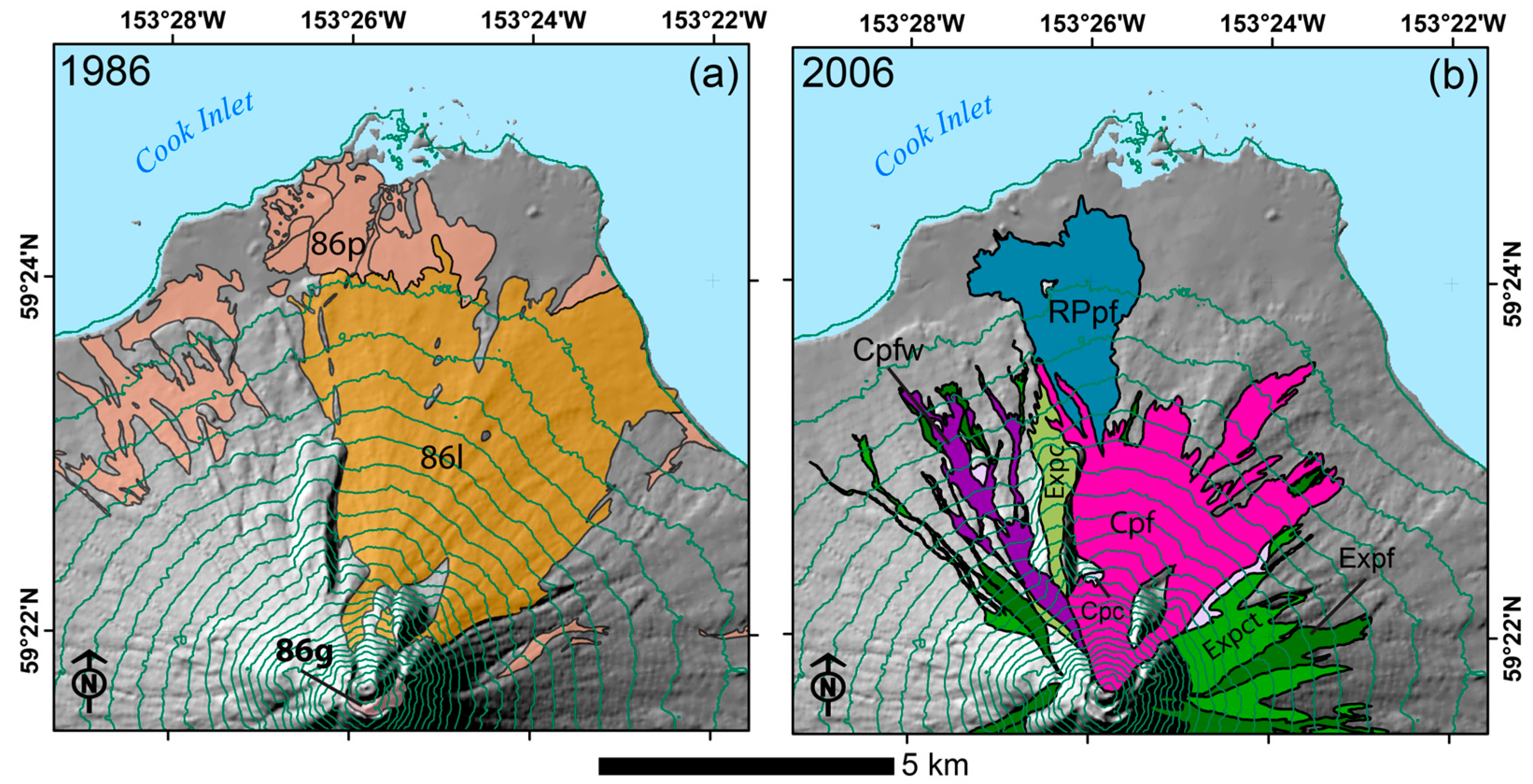
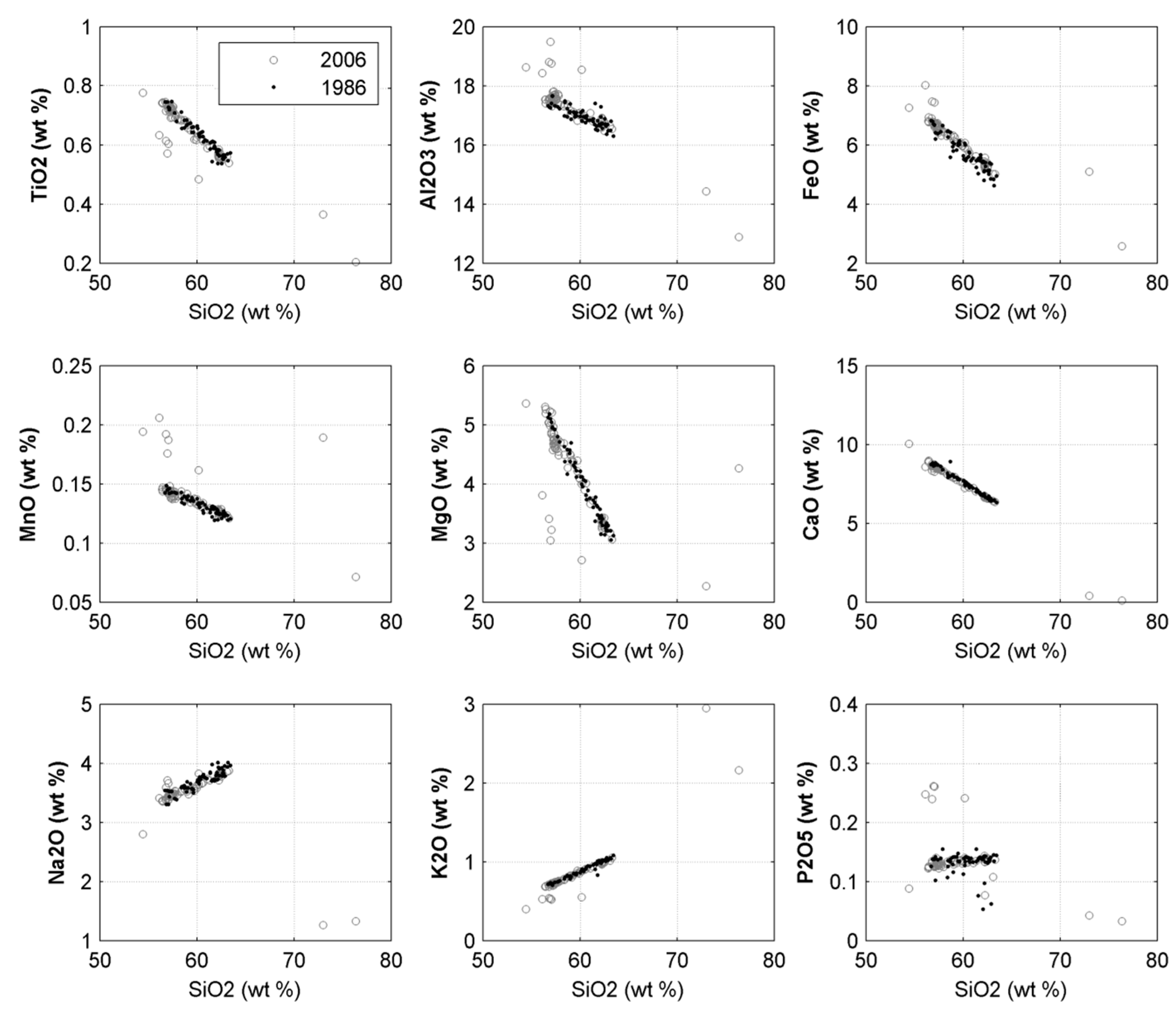
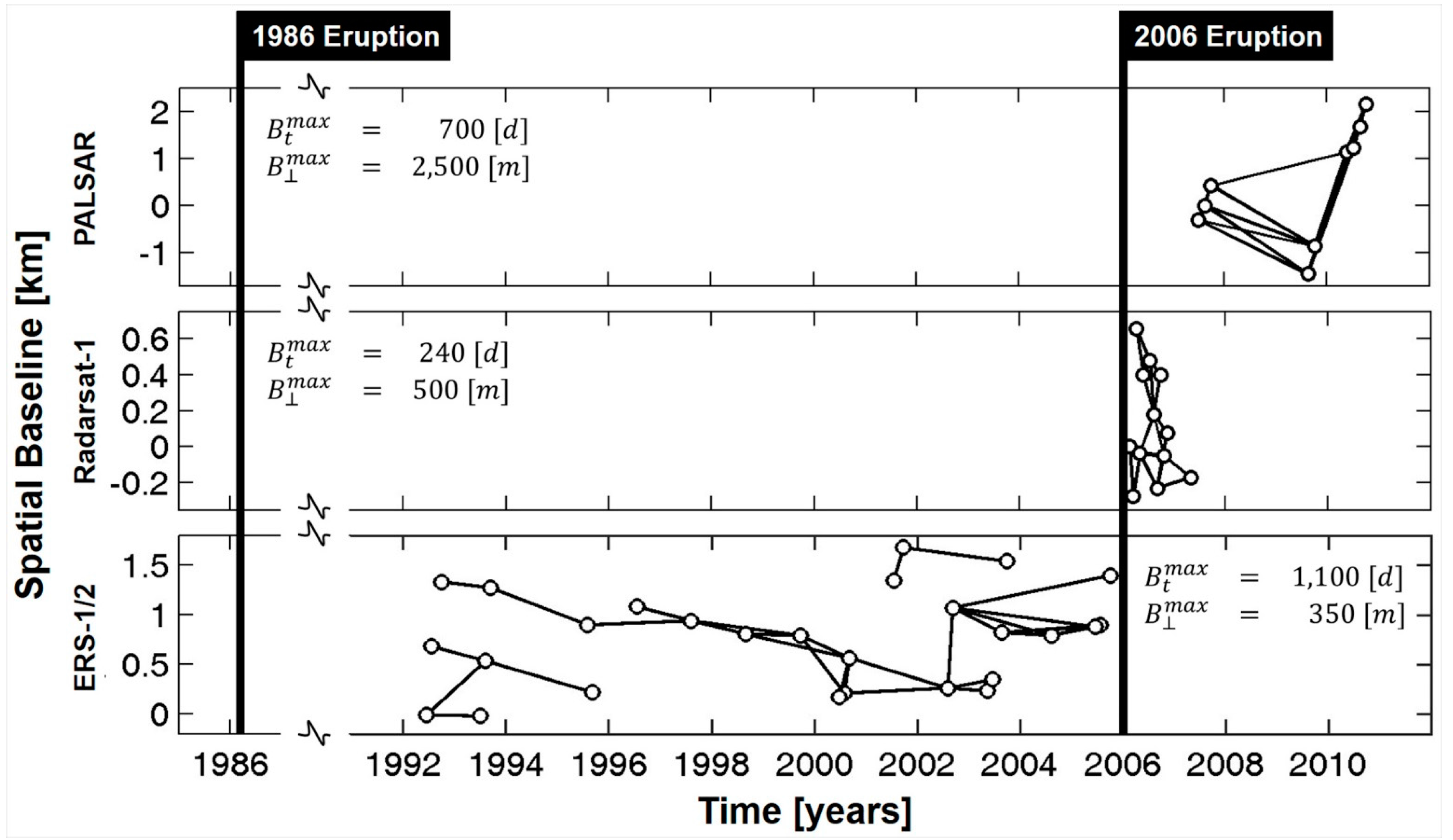
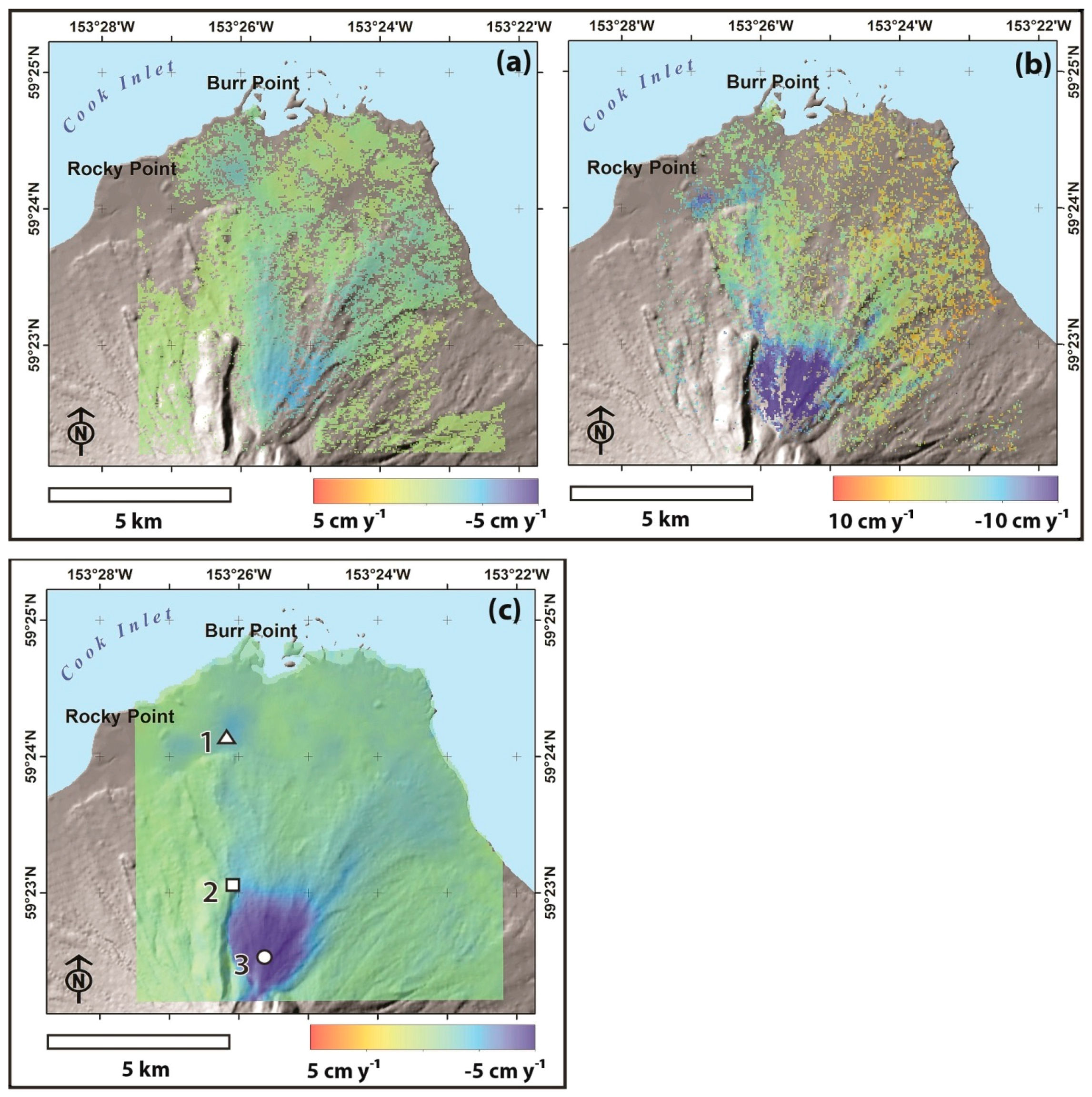

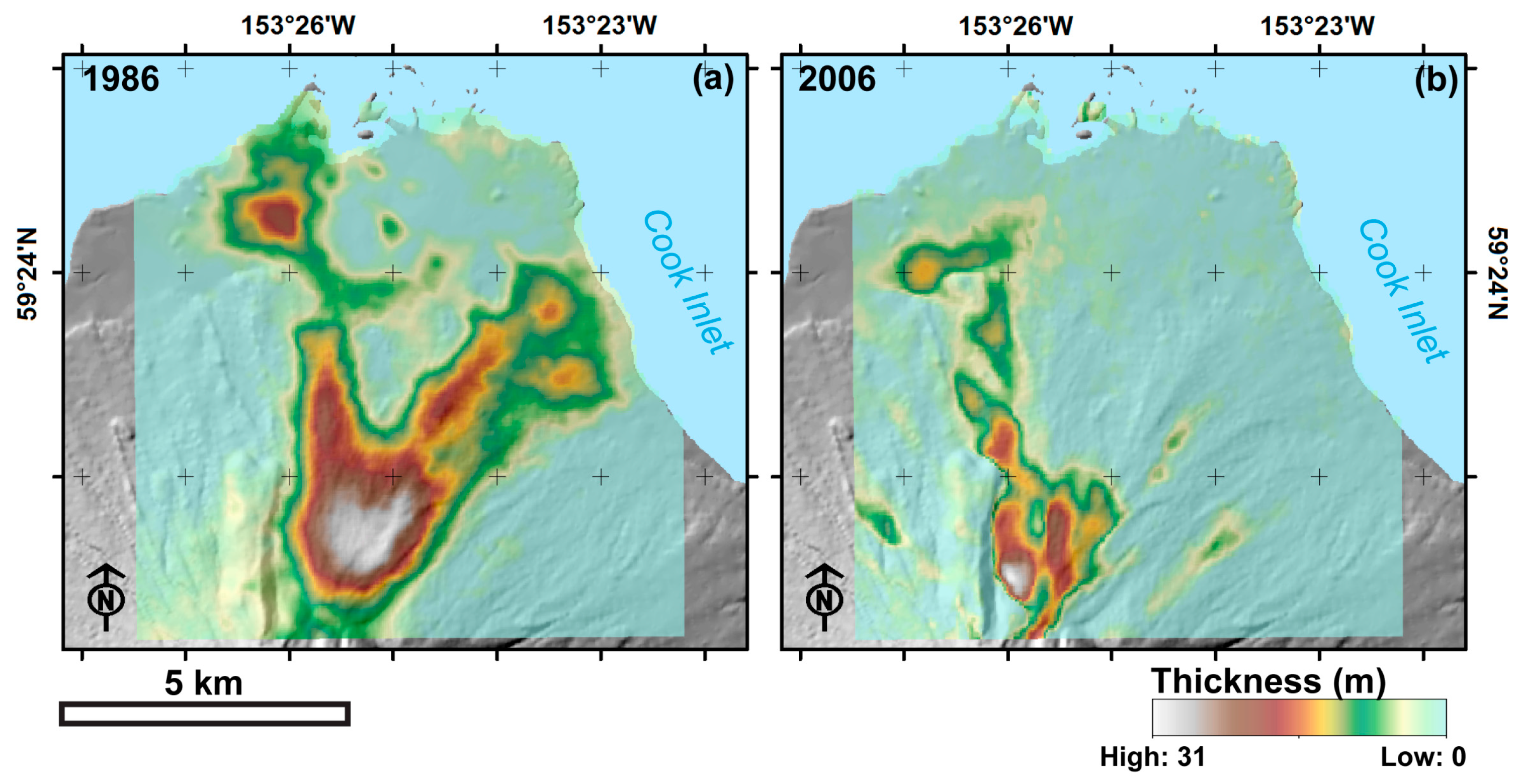

| Granule | Platform | Date | Orbit | Path | Frame | Ascending/Descending |
|---|---|---|---|---|---|---|
| E1_04883_STD_F301 | ERS1 | 21 June 1992 | 4883 | 229 | 301 | D |
| E1_05384_STD_F301 | ERS1 | 26 July 1992 | 5384 | 229 | 301 | D |
| E1_06386_STD_F301 | ERS1 | 4 October 1992 | 6386 | 229 | 301 | D |
| E1_10394_STD_F301 | ERS1 | 11 July 1993 | 10,394 | 229 | 301 | D |
| E1_10895_STD_F301 | ERS1 | 15 August1993 | 10,895 | 229 | 301 | D |
| E1_11396_STD_F301 | ERS1 | 19 September 1993 | 11,396 | 229 | 301 | D |
| E1_21259_STD_F301 | ERS1 | 8 August 1995 | 21,259 | 229 | 301 | D |
| E1_21760_STD_F301 | ERS1 | 12 September 1995 | 21,760 | 229 | 301 | D |
| E2_06596_STD_F301 | ERS2 | 24 July 1996 | 6596 | 229 | 301 | D |
| E2_12107_STD_F301 | ERS2 | 13 August 1997 | 12,107 | 229 | 301 | D |
| E2_17618_STD_F301 | ERS2 | 2 September 1998 | 17,618 | 229 | 301 | D |
| E2_23129_STD_F301 | ERS2 | 22 September 1999 | 23,129 | 229 | 301 | D |
| E2_27137_STD_F301 | ERS2 | 28 June 2000 | 27,137 | 229 | 301 | D |
| E2_27638_STD_F301 | ERS2 | 2 August 2000 | 27,638 | 229 | 301 | D |
| E2_28139_STD_F301 | ERS2 | 6 September 2000 | 28,139 | 229 | 301 | D |
| E2_32648_STD_F301 | ERS2 | 18 July 2001 | 32,648 | 229 | 301 | D |
| E2_33650_STD_F301 | ERS2 | 26 September 2001 | 33,650 | 229 | 301 | D |
| E2_38159_STD_F301 | ERS2 | 7 August 2002 | 38,159 | 229 | 301 | D |
| E2_38660_STD_F301 | ERS2 | 11 September 2002 | 38,660 | 229 | 301 | D |
| E2_42167_STD_F301 | ERS2 | 14 May 2003 | 42,167 | 229 | 301 | D |
| E2_42668_STD_F301 | ERS2 | 18 June 2003 | 42,668 | 229 | 301 | D |
| E2_43670_STD_F301 | ERS2 | 27 August 2003 | 43,670 | 229 | 301 | D |
| E2_44171_STD_F301 | ERS2 | 1 October 203 | 44,171 | 229 | 301 | D |
| E2_48680_STD_F301 | ERS2 | 11 August 2004 | 48,680 | 229 | 301 | D |
| E2_53189_STD_F301 | ERS2 | 22 June 2005 | 53,189 | 229 | 301 | D |
| E2_53690_STD_F301 | ERS2 | 27 July 2005 | 53,690 | 229 | 301 | D |
| E2_54692_STD_F301 | ERS2 | 5 October 2005 | 54,692 | 229 | 301 | D |
| R1_53774_ST6_F149 | R1 | 22 February 2006 | 53,774 | 182 | 149 | A |
| R1_54117_ST6_F149 | R1 | 18 March 2006 | 54,117 | 182 | 149 | A |
| R1_54460_ST6_F149 | R1 | 11 April 2006 | 54,460 | 182 | 149 | A |
| R1_54803_ST6_F149 | R1 | 5 May 2006 | 54,803 | 182 | 149 | A |
| R1_55146_ST6_F149 | R1 | 29 May 2006 | 55,146 | 182 | 149 | A |
| R1_55832_ST6_F149 | R1 | 16 July 2006 | 55,832 | 182 | 149 | A |
| R1_56175_ST6_F149 | R1 | 9 August 2006 | 56,175 | 182 | 149 | A |
| R1_56518_ST6_F149 | R1 | 2 September 2006 | 56,518 | 182 | 149 | A |
| R1_56861_ST6_F149 | R1 | 26 September 2006 | 56,861 | 182 | 149 | A |
| R1_57204_ST6_F149 | R1 | 20 October 2006 | 57,204 | 182 | 149 | A |
| R1_57547_ST6_F149 | R1 | 13 November 2006 | 57,547 | 182 | 149 | A |
| R1_59948_ST6_F149 | R1 | 30 April 2007 | 59,948 | 182 | 149 | A |
| ALPSRP076331180 | PALSAR | 1 July 2007 | 7633 | 270 | 1180 | A |
| ALPSRP083041180 | PALSAR | 16 August 2007 | 8304 | 270 | 1180 | A |
| ALPSRP089751180 | PALSAR | 1 October 2007 | 8975 | 270 | 1180 | A |
| ALPSRP190401180 | PALSAR | 21 August 2009 | 19,040 | 270 | 1180 | A |
| ALPSRP197111180 | PALSAR | 6 October 2009 | 19,711 | 270 | 1180 | A |
| ALPSRP230661180 | PALSAR | 24 May 2010 | 23,066 | 270 | 1180 | A |
| ALPSRP237371180 | PALSAR | 9 July 2010 | 23,737 | 270 | 1180 | A |
| ALPSRP244081180 | PALSAR | 24 August 2010 | 24,408 | 270 | 1180 | A |
| ALPSRP250791180 | PALSAR | 9 October 2010 | 25,079 | 270 | 1180 | A |
| Our Research | Swanson and Kienle [64] | Masterlark et al., Model [20] | Masterlark et al., DEM [20] | |
|---|---|---|---|---|
| Mean thickness (m) | 7.4 | n/r | 9.3 | n/r |
| Maximum Thickness (m) | 31.5 | n/r | 126 | n/r |
| Volume (m3) | 4.6e7 | 5e7 | 2.1e7 | 9.9e6 |
© 2016 by the authors; licensee MDPI, Basel, Switzerland. This article is an open access article distributed under the terms and conditions of the Creative Commons Attribution (CC-BY) license (http://creativecommons.org/licenses/by/4.0/).
Share and Cite
McAlpin, D.B.; Meyer, F.J.; Gong, W.; Beget, J.E.; Webley, P.W. Pyroclastic Flow Deposits and InSAR: Analysis of Long-Term Subsidence at Augustine Volcano, Alaska. Remote Sens. 2017, 9, 4. https://doi.org/10.3390/rs9010004
McAlpin DB, Meyer FJ, Gong W, Beget JE, Webley PW. Pyroclastic Flow Deposits and InSAR: Analysis of Long-Term Subsidence at Augustine Volcano, Alaska. Remote Sensing. 2017; 9(1):4. https://doi.org/10.3390/rs9010004
Chicago/Turabian StyleMcAlpin, David B., Franz J. Meyer, Wenyu Gong, James E. Beget, and Peter W. Webley. 2017. "Pyroclastic Flow Deposits and InSAR: Analysis of Long-Term Subsidence at Augustine Volcano, Alaska" Remote Sensing 9, no. 1: 4. https://doi.org/10.3390/rs9010004






